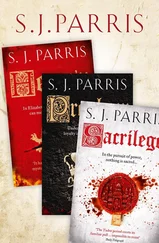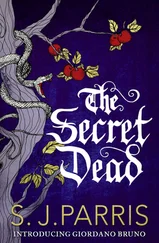Only the ambassador’s butler sees me slip out through the front door, my cloak pulled up around my head. He can tell Marie and Courcelles that I have left if he pleases; I have decided that if I keep to the main thoroughfares and stay among crowds there is less chance of meeting the same end as Dumas. On the other hand, it is easier to stick a knife in a man’s ribs and disappear in a crowd. I keep the bone-handled knife at my belt, one hand on its hilt, my eyes raking the street to either side.
At the Fleet Bridge, I hear footsteps at my back and whip around so fast that my pursuer will not have time either to hide or to pounce, but the only person I see is a skinny boy who freezes, gaping at me nervously. His eyes flicker to the hand beneath my cloak, and I recognise him as the kitchen boy Jem from Whitehall Palace, the one who had brought the fateful message to Abigail Morley that lured her to her death. I let go of the dagger and step towards him, trying to make my expression less forbidding. He draws a paper out from his jerkin.
‘Jem? How long have you been following me?’
‘From Salisbury Court, please you, sir. She told me to wait outside and catch you whenever you came out. She said I was not to be seen.’
‘Who did?’
‘I am to give you this, sir,’ he says, holding out the paper.
I glance at the seal, but it means nothing. Quickly I tear the paper open and find, to my surprise, a summons from Lady Seaton, the queen’s Lady of the Bedchamber. She is visiting friends at Crosby Hall in Bishopsgate Street and has something to impart to me; I am to find her there by knocking at the trade entrance and asking for her manservant. In any other circumstances, the imperious tone of this note would tempt me to ball it in my fist and throw it aside, but I suspected when I spoke to Lady Seaton that night at Richmond Palace, after the murder of Cecily Ashe, that she knew more than she was willing to say. Why she has suddenly decided to speak to me now, I do not know; neither do I discount the possibility that it might be a trap. The boy hovers uncertainly, unsure as to whether his duty is dispatched.
‘Thank you, Jem. When were you sent with this?’
‘Only this morning, sir. After breakfast.’
‘I wonder you have the stomach to carry any more messages.’
He looks at me with a pained expression.
‘I must eat, sir.’
‘Yes, of course.’
I squint up at the sky; in this thin light it is impossible to guess at the position of the sun, but the hour must be already past three. She will be awaiting me now, if the note is really from her. I wonder briefly about giving the boy a shilling to accompany me through the city but decide against it; anyone who wants to attack me would not think twice about getting the boy out of the way, and I cannot risk any further violence to anyone on my account. I reach into the purse inside my doublet and find a groat; he pockets it gratefully and runs back westwards along Fleet Street, slipping easily among the people and carts. I scan the street uneasily after he has dis appeared, but the Londoners walking towards the Lud Gate press on, heads down, wrapped in cloaks against the wind, passing me by without remark. No one is watching, yet I feel the city’s eyes on me, from doorways and side streets and blank windows, as exposed as surely as if I were walking through the streets naked.
With Lady Seaton’s letter in my hand, I turn and continue towards the gatehouse ahead, its turrets jutting above the high city wall, but my nerves are wound as tight as Dumas’s were on our last journey together; I start like a hare at the slightest movement at the edge of sight. I cast my mind back to the night of the concert at Whitehall, to the hushed conference in Burghley’s room when the boy Jem told his story. He did not seem to me bright enough to be anything other than honest, but there is an outside chance that he knowingly delivered a false message to Abigail to trap her, and that he might now have been used by the same person to draw me. The man in the hat — who was he? Marie and Courcelles’s unknown third man? But if Jem was lying, the man in the hat may not even exist; he might have been given his errand by someone he knew from the court and would not name.
My thoughts preoccupied in this way, I pass under the Lud Gate, squeezing my way through a flock of sorry-looking sheep and trying not to glance up at the rotten hunk of human meat spiked over the central arch, a reminder to the citizens of the price of treason. Instead of heading down to St Andrew’s Hill, I make my way along Cheapside, the wide stone-paved thoroughfare that bisects the City east to west. Here I grow certain that I am being followed, though each time I turn I fear I am just too slow to catch him, and I have seen nothing to give flesh to my fears, except glimpses of a cloak whisked into a doorway which might have been imagined. It is more that I sense him, his movements shadowing mine, his eyes on my back as I walk. Between the ornate fronts of the goldsmiths’ workshops, their colourful signs creaking and swaying like banners overhead, the alleyways offer ample opportunity to hide, but if I keep to the centre of the road, avoiding those on horseback and the pedlars’ carts, I hope to give myself time and space to react if anyone draws too close.
At the eastern end of Cheapside, where the Stocks Market and the Great Conduit stand, I turn north along Three Needle Street, past the grand facade of the Royal Exchange, the Flemish-designed building that looks as if it has been lifted straight from the Low Countries and dropped in the middle of London. Immediately you see that this is the part of the City where wealth gathers; merchants in expensive furs and feathered caps hurry up and down the steps of the Royal Exchange and the large houses set back from the road behind their walls are either newly built with lavish windows or converted from grand monastic buildings refurbished after the queen’s father had them closed down. Even so, where money gathers so does desperation; beggars with only the merest covering of rags between them and the October damp hover near about the steps, plaintively calling for alms from well-fed, fur-swaddled traders. At least here, with more wealth visible, people also seem to be more vigilant; outside the Exchange are liveried guards with pikestaffs, and some of the well-dressed citizens go about flanked by menservants. If whoever is pursuing me has come this far — and some instinct tells me he is near at hand — he will need to move cautiously.
I find Crosby Hall at the southern end of Bishopsgate Street, a fine new house with a gabled front of red brick and pale stone trim. A narrow alley runs alongside the garden wall and I guess that the trade entrance is to be found here; as I turn the corner, a wave of cold fear washes over me and I draw my dagger, expecting that if the assault is to come, it will be now, away from passers-by. A door clicks; I brace myself ready to lunge, the knife held before me as a young woman with a covered basket emerges from a small gate in the wall and screams with as much vigour as if I had actually stabbed her.
‘I’m so sorry,’ I say, sheathing the knife as I scramble to help her pick up her fallen laundry, but she backs up against the wall and continues shrieking as if all the legions of hell were at her heels. I conclude that my accent is not helping. A large balding man in a smeared kitchen apron sticks his head out of the gate, his fists clenched.
‘What’s all this?’
‘Forgive me — misunderstanding — I am here to see Lady Seaton? My name is Giordano Bruno.’
‘I don’t give two shits for your foreign name, ain’t no Lady Seaton lives here. Now get away before I kick you out on your dirty Spanish arse.’
‘He’s got a knife,’ the girl says, pointing, as she tucks herself behind his meaty shoulder.
Читать дальше
Конец ознакомительного отрывка
Купить книгу












